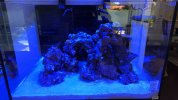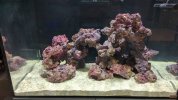Hi folks!
Long time lurker in various reefing channels. My name is Nabil and I live in south San Jose near the top of the Alamaden area. I’ve decided to more actively engage in the community with my own build thread! I’ve been in the hobby since I was in high school (with some lengthy breaks for school, move all around the country, kids, etc). My current tank is an 81G mixed reef tank that I wanted to tell you all about. It’s been running for a little less than a year.
Equipment
Tank: Fiji cube 81G INT middle (white stand)
Lighting: 2x Noopsyche K7 Pro V3
Sump: Fiji 24
Filter: Klir fleece roller
Skimmer: Reef Octopus EsSense S-130
UV: Green killing machine 24w UV
Heater: Hygger 500w
Reactor: BRS with sicce 1.0 pump (has carbon right now, used to run GFO in it)
Fuge light: Tunze eco chic
Return pump: reefbreeders nautilus 2500
Powerhead: MP40
Control: Hydros X4, XP8, X2, and XS all in a collective (more details to come on this)
RO: Koolermax 5 stage with buddy booster pump
Fish (the ones with names are courtesy of my kids)
Sailfin tang (big giant)
Hoevens wrasse (edward)
Bicolor angel (barry)
Coral beauty angel (bella)
Longnose hawkfish (schruder)
Blue green chromis
Lemon damsel
Ocellarus clown (cheech)
Midas blenny (mitch mcconnel)
Neon cleaner goby
Inverts
Mexican turbo snails
Astrea snails
Margarita snails
Tuxedo urchins
Black urchin
Brittle star
Serpent star
Long tentacle anemone
Bubble tip anemone
Coral banded shrimp
Corals
Duncan
Green star polyp
Lobophyllia
Goni of some sort
Cotton candy torch
Octospawn
Zoas
Acan
One fledgling SPS
A few mushrooms
In a future post, I’ll walk through my Hydros controller setup (which I may have gone a little nuts and tried to connect everything to it). I’ve got small daily automatic water changes going from a small fish room under my stairs. I’ve also done some fancy programming of the hydros to hook up a button box from JB aquatics.
I’ve also got a home-made battery backup for my MP40 that is kind of slick in that it only turns on when the house power is out. This way I can use my Hydros to turn the MP40 off at the power strip for maintenance or feeding without the battery keeping it on. Will cover how I did that in another future post.
And now some random pictures! (some are old from when i first set up the tank, and others are more recent).
Long time lurker in various reefing channels. My name is Nabil and I live in south San Jose near the top of the Alamaden area. I’ve decided to more actively engage in the community with my own build thread! I’ve been in the hobby since I was in high school (with some lengthy breaks for school, move all around the country, kids, etc). My current tank is an 81G mixed reef tank that I wanted to tell you all about. It’s been running for a little less than a year.
Equipment
Tank: Fiji cube 81G INT middle (white stand)
Lighting: 2x Noopsyche K7 Pro V3
Sump: Fiji 24
Filter: Klir fleece roller
Skimmer: Reef Octopus EsSense S-130
UV: Green killing machine 24w UV
Heater: Hygger 500w
Reactor: BRS with sicce 1.0 pump (has carbon right now, used to run GFO in it)
Fuge light: Tunze eco chic
Return pump: reefbreeders nautilus 2500
Powerhead: MP40
Control: Hydros X4, XP8, X2, and XS all in a collective (more details to come on this)
RO: Koolermax 5 stage with buddy booster pump
Fish (the ones with names are courtesy of my kids)
Sailfin tang (big giant)
Hoevens wrasse (edward)
Bicolor angel (barry)
Coral beauty angel (bella)
Longnose hawkfish (schruder)
Blue green chromis
Lemon damsel
Ocellarus clown (cheech)
Midas blenny (mitch mcconnel)
Neon cleaner goby
Inverts
Mexican turbo snails
Astrea snails
Margarita snails
Tuxedo urchins
Black urchin
Brittle star
Serpent star
Long tentacle anemone
Bubble tip anemone
Coral banded shrimp
Corals
Duncan
Green star polyp
Lobophyllia
Goni of some sort
Cotton candy torch
Octospawn
Zoas
Acan
One fledgling SPS
A few mushrooms
In a future post, I’ll walk through my Hydros controller setup (which I may have gone a little nuts and tried to connect everything to it). I’ve got small daily automatic water changes going from a small fish room under my stairs. I’ve also done some fancy programming of the hydros to hook up a button box from JB aquatics.
I’ve also got a home-made battery backup for my MP40 that is kind of slick in that it only turns on when the house power is out. This way I can use my Hydros to turn the MP40 off at the power strip for maintenance or feeding without the battery keeping it on. Will cover how I did that in another future post.
And now some random pictures! (some are old from when i first set up the tank, and others are more recent).
Attachments
-
 PXL_20231231_212538688.MP.jpg77.9 KB · Views: 192
PXL_20231231_212538688.MP.jpg77.9 KB · Views: 192 -
 IMG-20230513-WA0005.jpeg225.3 KB · Views: 181
IMG-20230513-WA0005.jpeg225.3 KB · Views: 181 -
 IMG-20230513-WA0007.jpeg185.1 KB · Views: 191
IMG-20230513-WA0007.jpeg185.1 KB · Views: 191 -
 IMG-20230522-WA0004.jpeg233.7 KB · Views: 191
IMG-20230522-WA0004.jpeg233.7 KB · Views: 191 -
 PXL_20230702_053348029.jpg94.5 KB · Views: 188
PXL_20230702_053348029.jpg94.5 KB · Views: 188 -
 PXL_20230709_194006101.jpg139.4 KB · Views: 191
PXL_20230709_194006101.jpg139.4 KB · Views: 191 -
 PXL_20231212_024357043.jpg160.6 KB · Views: 190
PXL_20231212_024357043.jpg160.6 KB · Views: 190 -
 PXL_20231219_022221409.jpg100.1 KB · Views: 179
PXL_20231219_022221409.jpg100.1 KB · Views: 179 -
 PXL_20231231_212516614.jpg140.8 KB · Views: 183
PXL_20231231_212516614.jpg140.8 KB · Views: 183

